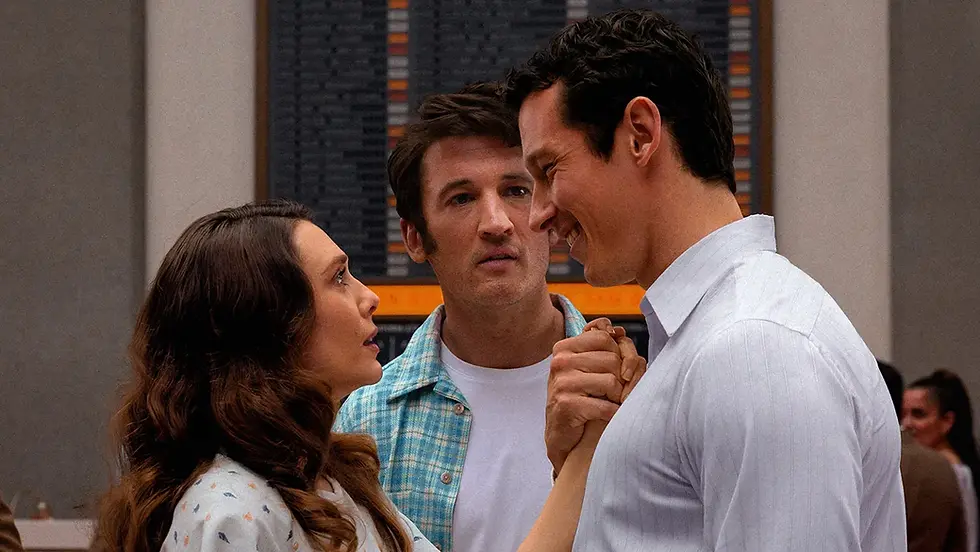‘F1: The Movie’ review: A high-octane racing flick that mostly stays on track
- Nate Adams

- Jun 25
- 3 min read

Courtesy of Warner Bros/Apple TV+
Boogity boogity boogity, let’s go racin’…
Director Joseph Kosinski, who last strapped audiences into fighter jets with “Top Gun: Maverick,” now brings his IMAX-honed instincts to the wide-screen spectacle of Formula One racing. Designed in partnership with the sport’s real-world organizers, “F1: The Movie” has plenty of high-octane 220 mph authenticity and under-the-hood detail. What it lacks is emotional torque and the narrative swagger to shift into that next gear.
Kosinski reunites most of the “Maverick” team: producer Jerry Bruckheimer, co-writer Ehren Kruger (flying solo this time), and composer Hans Zimmer, whose pulsing score elevates the tension and immerses viewers in the roar and rhythm of the racetrack. Even for non-fans, “F1” does an admirable job breaking down the mechanics of the sport, though sometimes to the point of overload.
The story itself is a familiar lap. Much like “Maverick,” it centers on a seasoned veteran brought back to train the next generation. We’ve seen this before. Many, many times before. But while Tom Cruise delivers every line and stunt with daredevil charisma, Brad Pitt relies more on his effortless cool and understated gravitas. He’s game here, even if he’s missing some of that Cliff Booth swagger. And no, he’s probably not doing the driving himself (Cruise would’ve learned and risked death trying).
Pitt plays Sonny Hayes, an ultra-smooth, cowboy-like racing vet we first meet sleeping in a van, headphones in, waiting for his wake-up call before a race. This guy has been around. He washes his face, steps out, and takes on an eight-hour stint at Daytona. Everyone around the track knows the name. Turns out Sonny’s a legend in the sport, despite never winning a major Grand Prix. His once-promising career was cut short by a near-fatal crash.
But when his old friend Reuben (Javier Bardem) calls, Sonny answers. Reuben needs him to save his floundering F1 team, APX, from being sold off by a board of impatient executives. The mission? Win some races and mentor the young hotshot driver, Noah Pearce (Damson Idris). Sonny says no, of course. And then, in the very next scene, he shows up at the pit. Because obviously.
What follows is a standard clash of egos between the cocky rookie and the jaded veteran. This eats up much of the film’s early runtime, and the tension feels forced and predictable. But once Kosinski eases off that throttle, “F1” finds its rhythm. The film never fully escapes its bloated runtime or multiple fake-out endings, but when it focuses on the world of Formula One itself, it hums with real energy.
The supporting team is solid. Kerry Condon brings quiet strength as APX’s technical director Kate McKenna, and Kim Bodnia adds a dose of gravitas as the no-nonsense Kaspar Molinski. Together, they ground the world in a sense of expertise and real-world stakes.
The production has clearly been given the red carpet treatment. Formula One opened its doors wide, giving the filmmakers unmitigated access to real races, drivers, and pit lanes, and the results are stunning. Specialized IMAX cameras capture both the interior and exterior of the cars in first-person POV with breathtaking clarity. The camera glides with a smoothness rarely seen on this scale. Editor Billy Weber keeps the races tight and kinetic, never confusing, always thrilling. The racing becomes its own character.
And that’s when the movie works best: when it lets the roar of the engines and the blur of tires do the talking. There’s a particular joy in watching Sonny exploit loopholes in the rulebook for an edge, those moments popping with tension and wit. They’re smart, fun, and help guide newcomers through the complexity of the sport without bogging things down.
But does the movie offer anything deeper beneath the hood? Not really. That’s its biggest shortcoming. Pitt, especially by the final act, feels like he’s coasting. His banter with Idris never quite clicks. The emotional arcs never fully land. Characters remain flat, mostly unchanged from start to finish. And the choice to have nearly every race sequence narrated by broadcast commentators wears thin fast. At some point, you have to trust the audience to follow the action without being handheld.
Naturally, it all builds to one last big race, complete with swelling music, tight turns, and dramatic overtakes. And to be fair, it delivers. The final race is a knockout. It’s the rest of the film that feels more hesitant. “F1” wants to soar, and it often does, but it’s weighed down by too many tired tropes and not enough fuel in the character department.
It doesn’t quite reach the apex it’s chasing, but when it lets the engines speak for themselves, “F1” earns its lap around victory lane. Just maybe not in the pole position.
Grade: B
F1: THE MOVIE is now playing in theaters.





Comments